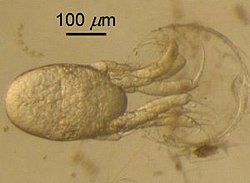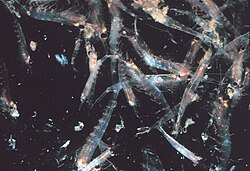Krill
Krill are small shrimp-like crustaceans about an inch or so long, found in all the oceans of the world. In areas with nutrients,[1] they occur in huge swarms, with more than 10,000 krill per cubic meter. They feed on phytoplankton and to a lesser extent zooplankton.
| Euphausiacea | |
|---|---|

| |
| Northern krill | |
| Scientific classification | |
| Kingdom: | |
| Phylum: | |
| Subphylum: | |
| Class: | |
| Order: | Euphausiacea
|
| Families | |
| |
Krill are ecologically very important, because they are near the bottom of the food chain. They make up the largest part of the diet of many animals. In the Southern Ocean, one species, the Antarctic krill, Euphausia superba, makes up an estimated biomass of over 500,000,000 tonnes (490,000,000 long tons; 550,000,000 short tons), roughly twice that of the human race. They are eaten by many animals, including whales, seals, penguins, birds, fish, squid, and whale sharks. Of this, over half is eaten by each year, and is replaced by growth and reproduction.
Most krill species make large vertical migrations. They are distinguished from other crustaceans such as true shrimp by their externally visible gills.
Taxonomy
The order Euphausiacea is divided into two families, Bentheuphausiidae and Euphausiidae. the first has one species, the second has 85 species. Well known species are the Antarctic krill (Euphausia superba), Pacific krill (Euphausia pacifica) and Northern krill (Meganyctiphanes norvegica).
Bioluminescence
Except for Bentheuphausia amblyops, krill are bioluminescent. They have organs called photophores which emit light. The light is made by an enzyme-catalysed chemiluminescence reaction. A luciferin (a kind of pigment) is activated by a luciferase enzyme.[2] Krill probably get this substance as part of their diet, which contains dinoflagellates.[3] Krill photophores are complex organs with lenses and focusing abilities, and can be rotated by muscles.[4] The exact function of these organs is not known. The possibilities include mating, social interaction or as a form of camouflage to compensate for their shadow against the overhead light.[5][6]
Krill Media
The gills of krill are externally visible
A nauplius of Euphausia pacifica hatching, emerging backwards from the egg
The head of a female krill of the sac-spawning species Nematoscelis difficilis with her brood sac. The eggs have a diameter of 0.3–0.4 millimetres (0.012–0.016 in)
Beating pleopods of a swimming Antarctic krill
Deep-frozen plates of Antarctic krill for use as animal feed and raw material for cooking
References
- ↑ Much of the ocean away from the continents is low on nutrients.
- ↑ O. Shimomura (1995). "The roles of the two highly unstable components F and P involved in the bioluminescence of euphausiid shrimps". Journal of Bioluminescence and Chemiluminescence. 10 (2): 91–101. doi:10.1002/bio.1170100205. PMID 7676855.
- ↑ J.C. Dunlap, J.W. Hastings & O. Shimomura (1980). "Crossreactivity between the light-emitting systems of distantly related organisms: novel type of light-emitting compound". Proceedings of the National Academy of Sciences. 77 (3): 1394–1397. Bibcode:1980PNAS...77.1394D. doi:10.1073/pnas.77.3.1394. JSTOR 8463. PMC 348501. PMID 16592787.[dead link]
- ↑ P.J. Herring & E.A. Widder (2001). "Bioluminescence in plankton and nekton". In J.H. Steele, S.A. Thorpe & K.K. Turekian (ed.). Encyclopedia of Ocean Science. Vol. 1. Academic Press, San Diego. pp. 308–317. ISBN 0-12-227430-X. Archived from the original on 2012-08-02. Retrieved 2012-09-03.
- ↑ S.M. Lindsay & M.I. Latz (1999). "Experimental evidence for luminescent countershading by some euphausiid crustaceans" in American Society of Limnology and Oceanography (ASLO) Aquatic Sciences Meeting. .
- ↑ Sönke Johnsen (2005). "The red and the black: bioluminescence and the color of animals in the deep sea" (PDF). Integrative and Comparative Biology. 4 (2): 234–246. doi:10.1093/icb/45.2.234. PMID 21676767.






